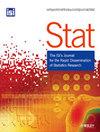D-optimal designs for multi-response linear models with two groups
IF 0.8
4区 数学
Q3 STATISTICS & PROBABILITY
引用次数: 0
Abstract
In recent years, multi-response linear models have gained significant popularity in various statistical applications. However, the design aspects of multi-response linear models with group-wise considerations have received limited attention in the literature. This paper aims to thoroughly investigate两组多反应线性模型的 D 优化设计
近年来,多反应线性模型在各种统计应用中大受欢迎。然而,文献中对分组考虑的多反应线性模型的设计方面关注有限。本文旨在深入研究此类模型的 D$$ D$$ 最佳设计。具体来说,我们将重点放在涉及两组的情况上,其中每组的观察值比例可以任意选择,也可以不选择。我们提出了两个等价定理来阐述 D$$ D$$ 最佳设计的特征。此外,我们还深入探讨了近似设计的可接受性,并建立了设计被视为可接受性的必要条件。我们还列举了几个示例来证明所得出的理论结果的应用。
本文章由计算机程序翻译,如有差异,请以英文原文为准。
求助全文
约1分钟内获得全文
求助全文
来源期刊

Stat
Decision Sciences-Statistics, Probability and Uncertainty
CiteScore
1.10
自引率
0.00%
发文量
85
期刊介绍:
Stat is an innovative electronic journal for the rapid publication of novel and topical research results, publishing compact articles of the highest quality in all areas of statistical endeavour. Its purpose is to provide a means of rapid sharing of important new theoretical, methodological and applied research. Stat is a joint venture between the International Statistical Institute and Wiley-Blackwell.
Stat is characterised by:
• Speed - a high-quality review process that aims to reach a decision within 20 days of submission.
• Concision - a maximum article length of 10 pages of text, not including references.
• Supporting materials - inclusion of electronic supporting materials including graphs, video, software, data and images.
• Scope - addresses all areas of statistics and interdisciplinary areas.
Stat is a scientific journal for the international community of statisticians and researchers and practitioners in allied quantitative disciplines.
 求助内容:
求助内容: 应助结果提醒方式:
应助结果提醒方式:


